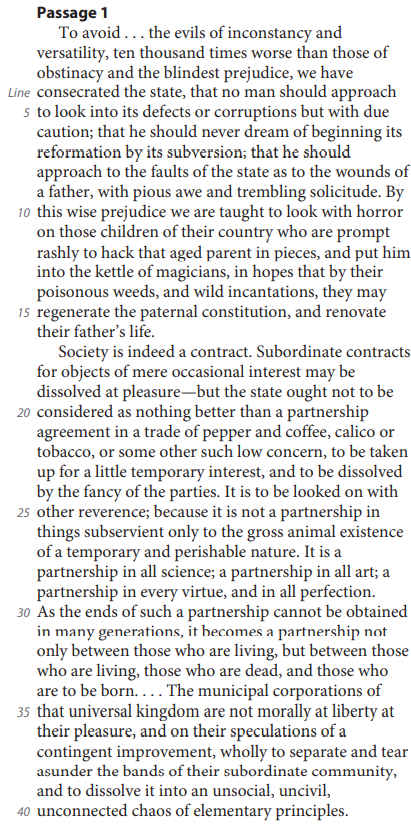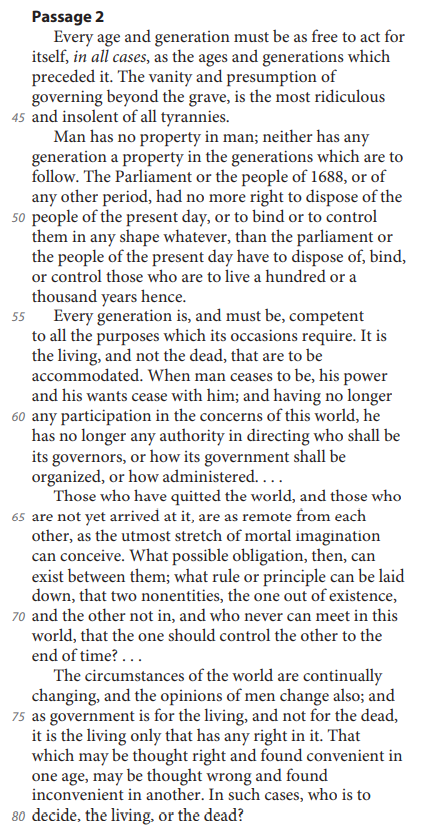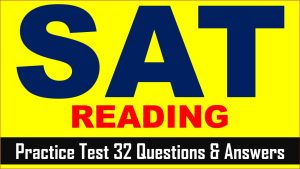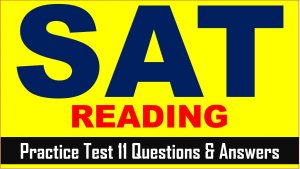SAT (Scholastic Assessment Test) is a standard test, used for taking admission to undergraduate programs of universities or colleges of the United States. SAT is developed and published by the College Board, an organization in the United States, administered by the Educational Testing Service. In this article of AKVTutorials, you will get Kaplan SAT Prep Plus Course Book Review | Practice Test 19 AMBiPi.
Kaplan SAT Prep Plus Course Book Review
Kaplan is enormous publishing company that releases various books and course for the SAT preparation and hence it following books for SAT preparations.
Check Price On Amazon
In this SAT prep book, there are following sections are made in each chapter.
“How Much Do You Know?”
“Check Your Work”
“Try on Your Own”
“How Much Have You Learned?”
Kaplan strategies provides a direction for the SAT preparation and explain each and every skill which is required for creaking SAT exam.
Hence, if you invest more in the preparation for SAT by studying Kaplan SAT practice questions sets, the greater your chances of getting higher SAT score and then you will be very close to get admission into your top-choice colleges.
In SAT exam, different questions of different topics are asked, which has different number of points (means SAT scores).
By analyzing these topics, Kaplan contains all those topics which are very close to appear in SAT papers.
Now, to master these topics, you need to earn a number of Smart Points on SAT test day.
Kaplan uses a 600-point scale for Smart Points in SAT prep plus book. The distribution of these points is as below.
- Smart Point for Linear Equation = 110
- Smart Point for Functions = 105
- Smart Point for Ratio Proportion & Percent = 70
- Smart Point for Geometry = 65
- Smart Point for Quadratic Equation = 60
- Smart Point for Statistics & Probability = 50
- Smart Point for System of Linear Equations = 45
- Smart Point for Inequalities = 35
- Smart Point for Scatter Plots = 25
- Smart Point for Exponents = 25
- Smart Point for Radicals Polynomials Expression = 5
- Smart Point for Trigonometry = 5
According to Kaplan SAT Math section, the SAT Math sections are distributed as below:
In Heart of Algebra of Kaplan SAT Book, Analyzing and solving equations and systems of equations; creating expressions, equations, and inequalities to represent relationships between quantities and to solve problems; rearranging and interpreting formulas.
In Problems Solving and Data Analysis of Kaplan SAT Book, Creating and analyzing relationships using ratios, proportions, percentages, and units; describing relationships shown graphically; summarizing qualitative and quantitative data.
In Passport to Advance Math of Kaplan SAT Book, using function notation; creating, analyzing, and solving quadratic and higher-order equations; manipulating polynomials to solve problems.
In Additional Topics in Math of Kaplan SAT Book, making area and volume calculations in context; investigating lines, angles, triangles, and circles using theorems; working with trigonometric functions and complex numbers.
According to Kaplan SAT Reading section, the SAT Reading sections will focus on your comprehension and reasoning skills when you are presented with challenging extended prose passages taken from a variety of content areas. Passages will draw from U.S. and World Literature, History/Social Studies, and Science. One set of History/Social Studies or Science passages will be paired. History/Social Studies and Science passages can also be accompanied by graphical representations of data such as charts, graphs, tables, and so on.
Kaplan SAT Prep Book Pros and Cons
Pros
- Kaplan SAT Prep Book contains all the three sections of SAT exam, which provides acceptable broad details of the SAT test.
- Five full length SAT Practice test. Two in the book and Three in Online.
- More than 2000 practice questions with detailed explanation.
- Pre-quizzes in each chapter which identify what you already know
- Mixed practice quizzes after every chapter to assess how much you have learned.
Cons
- The actual FREE College Board tests available on its official site, is not given in the SAT Prep Book.
SAT Reading Practice Passage
Passage 1 is adapted from Edmund Burke, Reflections on the Revolution in France. Originally published in 1790. Passage 2 is adapted from Thomas Paine, Rights of Man. Originally published in 1791.


SAT Reading Comprehension Practice Test Questions
SAT Practice Test 19 Question No 1
In Passage 1, Burke indicates that a contract between a person and society differs from other contracts mainly in its
Option A: brevity and prominence.
Option B: complexity and rigidity.
Option C: precision and usefulness.
Option D: seriousness and permanence.
SAT Practice Test 19 Answer No 1
Show/Hide Answer
Option D :
In lines 25-29, Burke describes the contract between a person and society as one that is “not a partnership in things subservient only to the gross animal existence of a temporary and perishable nature. It is a partnership in all science; a partnership in all art; a partnership in every virtue, and in all perfection.” Describing that contract as a partnership in all things indicates its seriousness while describing it as not being a “temporary and perishable nature” implies its permanence.
Choice A is incorrect because line 27 states that the contract between a person and society is not “temporary or perishable,” meaning it is not brief. Choices B and C are incorrect because the passage does not compare the contracts in terms of complexity or precision.
SAT Practice Test 19 Question No 2
As used in line 4, “state” most nearly refers to a
Option A: style of living.
Option B: position in life.
Option C: temporary condition.
Option D: political entity.
SAT Practice Test 19 Answer No 2
Show/Hide Answer
Option D :
In lines 1-9, Burke explains that people have “consecrated the state” to “avoid . . . the evils of inconstancy and versatility,” and that people should examine “the faults of the state . . . with pious awe and trembling solitude.” Burke then explains that society is taught to “look with horror on those children of their country who want to hack that aged parent in pieces” (lines 10-12). Burke is arguing that children want to revise the state, or “this aged parent,” by amending its faults. In this context, “state” refers to a political entity or government, that attempts to protect its citizens from “the evils of inconstancy and versatility.”
Choices A, B, and C are incorrect because in this context, “state” does not mean the style of living, position in life, or temporary condition.
SAT Practice Test 19 Question No 3
As used in line 22, “low” most nearly means
Option A: petty.
Option B: weak.
Option C: inadequate.
Option D: depleted.
SAT Practice Test 19 Answer No 3
Show/Hide Answer
Option A :
In lines 17-29, Burke argues that “subordinate contracts,” are simply business agreements over traded goods, while the state is not merely “a partnership agreement in a trade . . . or some other such low concern . . . but a partnership in all science; a partnership in all art; a partnership in every virtue, and in all perfection.” In this context, Burke is stating that the state is not a contract consisting of “low” or petty concerns.
Choices B, C, and D are incorrect because in this context, “low” does not mean weak, inadequate, or depleted.
SAT Practice Test 19 Question No 4
It can most reasonably be inferred from Passage 2 that Paine views historical precedents as
Option A: generally helpful to those who want to change society.
Option B: surprisingly difficult for many people to comprehend.
Option C: frequently responsible for human progress.
Option D: largely irrelevant to current political decisions.
SAT Practice Test 19 Answer No 4
Show/Hide Answer
Option D :
In lines 41-43, Paine asserts that “Every age and generation must be as free to act for itself, in all cases, as the ages and generations which preceded it.” He later states that deceased citizens of a state should no longer have “any authority in directing who shall be its governors, or how its government shall be organized, or how administered” (lines 61-63). Paine doesn’t believe, in other words, that the decisions of previous generations should dictate the conditions of modern life and government.
Choices A, B, and C are incorrect because they do not accurately characterize the way Paine views historical precedents.
SAT Practice Test 19 Question No 5
How would Paine most likely respond to Burke’s statement in lines 30-34, Passage 1 (“As the…born”)?
Option A: He would assert that the notion of a partnership across generations is less plausible to people of his era than it was to people in the past.
Option B: He would argue that there are no politically meaningful links between the dead, the living, and the unborn.
Option C: He would question the possibility that significant changes to a political system could be accomplished within a single generation.
Option D: He would point out that we cannot know what judgments the dead would make about contemporary issues.
SAT Practice Test 19 Answer No 5
Show/Hide Answer
Option B :
In lines 30-34, Burke describes societal contracts as long-term agreements that preserve the interests of past generations and link the living and the dead into a “partnership.” Paine, however, states that past generations have no “control” over the decisions made by living (line 71) because the dead have “no longer any participation in the concerns of this world” (lines 59-60).
Choices A, C, and D are incorrect because they do not accurately characterize how Paine would respond to Burke’s claim that societal contracts link past and current generations.
SAT Practice Test 19 Question No 6
Which choice provides the best evidence for the answer to the previous question?
Option A: Lines 41-43 (“Every… it”)
Option B: Lines 43-45 (“The vanity… tyrannies”)
Option C: Lines 56-58 (“It is… accommodated”)
Option D: Lines 67-72 (“What… time”)
SAT Practice Test 19 Answer No 6
Show/Hide Answer
Option D :
Lines 67-72 provide the best evidence that Paine would respond to Burke’s statement that society is a “partnership” between past and current generations (lines 30-34) with the explanation that the current generation cannot know what judgments the dead would make about contemporary issues. In these lines Paine explains: “What possible obligation, then, can exist between them; what rule or principle can be laid down, that two nonentities, the one out of existence, and the other not in, and who never can meet in this world, that the one should control the other to the end of time?”
Choices A, B, and C are incorrect because the lines cited do not provide the best evidence that Paine would respond to Burke’s statement that society is a “partnership” between past and current generations (lines 30-34) by arguing that the current generation cannot know what judgments the dead would make about contemporary issues.
SAT Practice Test 19 Question No 7
Which choice best describes how Burke would most likely have reacted to Paine’s remarks in the final paragraph of Passage 2?
Option A: With approval, because adapting to new events may enhance existing partnerships.
Option B: With resignation, because changing circumstances are an inevitable aspect of life.
Option C: With skepticism, because Paine does not substantiate his claim with examples of governments changed for the better.
Option D: With disapproval, because changing conditions are insufficient justification for changing the form of government.
SAT Practice Test 19 Answer No 7
Show/Hide Answer
Option D :
Paine concludes Passage 2 with the argument that because social issues change over time, the living should not try to adhere to decisions made by former generations (lines 73-80). Burke, however, states that living citizens exist within a “universal kingdom” (line 35) comprised of the living, the dead, and those who are not yet born. Burke argues that the living do not have the right to change their government based on “their speculations of a contingent improvement” (lines 36-37). Therefore, Burke would disapprove of Paine’s concluding argument, as he believes the living do not have sufficient justification for changing the existing governmental structure.
Choices A, B, and C are incorrect because they do not accurately describe how Burke would likely have responded to Paine’s remarks in the final paragraph of Passage 2.
SAT Practice Test 19 Question No 8
Which choice provides the best evidence for the answer to the previous question?
Option A: Lines 1-4 (“To avoid… state”)
Option B: Lines 7-9 (“he should… solicitude”)
Option C: Lines 27-29 (“It is… perfection”)
Option D: Lines 34-38 (“The municipal… community”)
SAT Practice Test 19 Answer No 8
Show/Hide Answer
Option D :
Lines 34-38 provide the best evidence that Burke would disapprove of Paine’s remarks in the final paragraph of Passage 2: “The municipal corporations of that universal kingdom are not morally at liberty at [the living’s] pleasure, and on their speculations of a contingent improvement, wholly to separate and tear asunder the bands of their subordinate community.” In these lines, Burke is arguing that the living do not have sufficient justification to change the existing governmental structure.
Choices A, B, and C do not provide the best evidence that Burke would disapprove of Paine’s remarks in the final paragraph of Passage 2, as Burke believes the living do not have sufficient justification for changing the existing governmental structure.
SAT Practice Test 19 Question No 9
Which choice best states the relationship between the two passages?
Option A: Passage 2 challenges the primary argument of Passage 1.
Option B: Passage 2 advocates an alternative approach to a problem discussed in Passage 1.
Option C: Passage 2 provides further evidence to support an idea introduced in Passage 1.
Option D: Passage 2 exemplifies an attitude promoted in Passage 1.
SAT Practice Test 19 Answer No 9
Show/Hide Answer
Option A :
The primary argument of Passage 1 is that an inviolable contract exists between a people and its government, one that is to be “looked on with other reverence” (lines 24-25). Passage 1 suggests that this contract exists between past and future generations as well; in effect, current and future generations should be governed by decisions made in the past. Passage 2 challenges these points, as it argues that current and future generations are not obligated to preserve past generations’ beliefs: “The Parliament or the people of 1688, or of any other period, had no more right to dispose of the people of the present day, or to bind or to control them in any shape whatever, than the parliament or the people of the present day have to dispose of, bind, or control those who are to live a hundred or a thousand years hence” (lines 48-54).
Choices B, C, and D are incorrect because Passage 2 does not offer an alternative approach to Passage 1, support an idea introduced in Passage 1, or exemplify an attitude promoted in Passage 1.
SAT Practice Test 19 Question No 10
The main purpose of both passages is to
Option A: suggest a way to resolve a particular political struggle.
Option B: discuss the relationship between people and their government.
Option C: evaluate the consequences of rapid political change.
Option D: describe the duties that governments have to their citizens.
SAT Practice Test 19 Answer No 10
Show/Hide Answer
Option B :
Passage 1 argues that the government is sacred (lines 3-6) and that no person should interfere with it (lines 6-9). Passage 2 argues that people have the right to make changes to their government: “The circumstances of the world are continually changing, and the opinions of men change also; and as government is for the living, and not for the dead, it is the living only that has any right in it” (lines 73-76).
Choices A, C, and D are incorrect because they do not identify the main purpose of both passages.







